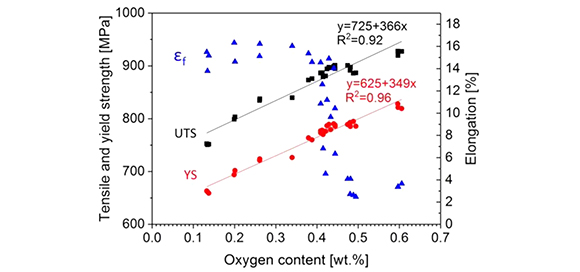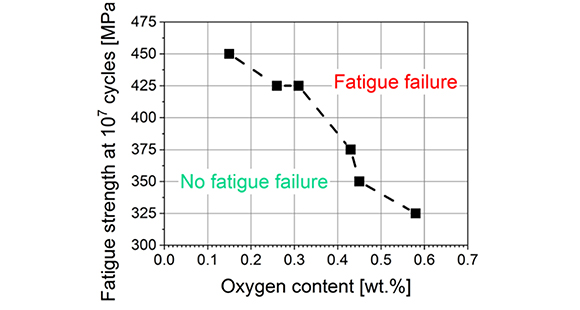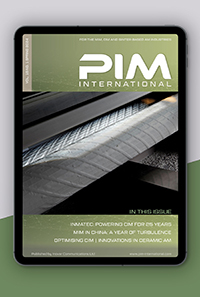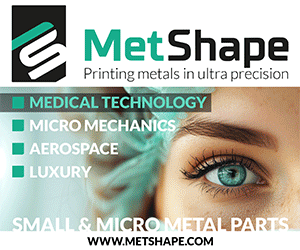High-oxygen MIM Ti-6Al-7Nb alloys with high tensile and fatigue properties
April 29, 2024
Although Metal Injection Moulding offers many advantages compared with other manufacturing processes in terms of near-net shape and good or very good mechanical properties for titanium alloy components, the production of high performance Ti alloy parts by MIM remains challenging.
One of the key issues with MIM Ti alloys is the uptake and control of interstitials and the development of a dedicated MIM Ti alloy, which is robust against high interstitial levels but still meets the requirement for strength and ductility, would greatly enhance the industry’s acceptance. Such a dedicated Ti alloy would additionally be attractive for Laser Beam Powder Bed Fusion (PBF-LB), Binder Jetting (BJT) and other Additive Manufacturing processes where economical powders with higher oxygen content could be used.
Research has been underway at the Helmholtz Zentrum Hereon, Geesthacht, Germany, in collaboration with Höganäs AB, Sweden, and the University of Applied Sciences and Arts Western Switzerland, Sion, Switzerland, to evaluate Ti-6Al-7Nb as an alternative to the Ti-6Al-4V alloy commonly-processed by MIM. The results of this research were published in a paper entitled: ‘High-oxygen MIM Ti-6Al-7Nb: Microstructure, tensile and fatigue properties’, by A A Hidalgo, T Ebel, R Frykholm, E Carreño-Morelli, and F Pyczak, in Materials Today Communications, Vol. 34, 2023, 104982, 10pp.
The authors stated that MIM Ti-6Al-7Nb was selected as an alternative to Ti-6Al-4V because of its slightly better biocompatibility resulting from the replacement of vanadium by niobium, and that the microstructures and mechanical properties of both alloys are very similar. Their focus in this research was, therefore, to understand the influence of oxygen on the tensile and high cycle fatigue (HCF) properties of Ti-6Al-7Nb processed by MIM and whether oxygen could purposely be used as a potent strengthener. The authors also aimed at establishing correlations between crystal structure and microstructure, and the tensile behaviour and HCF properties of sintered MIM Ti-6Al-7Nb specimens. Special attention was given to ascertain if excessive amounts of oxygen might cause a dramatic drop of ductility due to deformation mode changes and the evolution of non-equilibrium microstructures.
Two gas atomised spherical Ti-6Al-7Nb powders were produced in-house at Helmholtz-Zentrum Hereon: one using the PIGA technique (plasma induction melting guiding gas atomisation); and the other using a commercially extruded rod material by the EIGA technique (electrode induction melting gas atomisation). The interstitial contents of PIGA powders were 0.098 wt.% O, 0.002 wt.% C and 0.003 wt.% N, while EIGA powders contained 0.211 wt.% O, 0.004 wt.% C and 0.007 wt.% N. In both cases, the powder was sieved to −45 µm. The EIGA and PIGA produced Ti-6Al-7Nb powders were mixed with a multicomponent binder consisting of 35 wt.% ethylene vinyl acetate, 60 wt.% paraffin wax and 5 wt.% stearic acid. The powder loading was 64.5 vol.%.

The MIM Ti-6Al-7Nb feedstock was injection moulded to produce parts with low oxygen for standard tensile testing and also four-point bending fatigue testing. In order to analyse specimens with higher oxygen content (up to 0.61 wt.%), parts produced with the EIGA powders were first subjected to a pre-sintering step, followed by thermal treatment during which the specimens were exposed to an oxygen (20%)-argon atmosphere of 1 bar with flowing gas, and then finally sintered at 1,350°C for 4 h under high vacuum. The sintered MIM Ti-6Al-7Nb specimens exhibited around 3% of residual porosity. The authors reported no significant difference in residual porosity or shrinkage in specimens with different oxygen contents or different shape. The interstitial contents of the sintered MIM Ti-6Al-7Nb parts for tensile and fatigue testing are shown in Tables 1 and 2 respectively. The higher oxygen content was acquired when the specimens were exposed longer under the oxygen-argon atmosphere during presintering.

The sintered MIM Ti-6Al-7Nb alloys were subject to tensile testing on a servo-hydraulic system equipped with a 100 kN load cell at a strain rate of 1.2 × 10− 51/s at room temperature in air. High cycle fatigue (HCF) testing was done in a four-point bending fixture in air at room temperature. The surface of the sintered MIM test parts was shot peened prior to HCF testing in order to introduce compressive residual stress, improving the HCF strength. The maximum number of cycles was established at 107 cycles to define the fatigue life. Selected low-oxygen specimens and high-oxygen specimens were subjected to a HIP treatment at 920°C in argon atmosphere at 1,000 bar for 120 min to study the slip behaviour.

The authors reported on the properties achieved after tensile testing and the different mechanisms by which oxygen impacts the tensile behaviour of the MIM Ti-6Al-7Nb alloy. As can be seen in Fig. 1, oxygen addition improves tensile and yield strength. A significant drop in ductility was found at 0.38 wt.% of oxygen. Fig. 2 shows the dependency of fatigue strength on oxygen content after 107 cycles. It shows that fatigue resistance of MIM Ti-6Al-7Nb is continuously reduced with increasing oxygen content, but, in contrast to ductility, there is no visible sudden decrease at a specific oxygen level. Similar to tensile behaviour, interstitial oxygen has an impact on important factors related with the HCF behaviour.

This study supports the use of oxygen as an alloying element in MIM α + β titanium alloys for improving tensile strength without excessive loss of either ductility or HCF properties. However, special attention has to be paid if using an excessive amount of oxygen that might cause a dramatic drop of ductility due to deformation mode changes and evolution of non-equilibrium microstructures. The authors have determined that such a non-equilibrium microstructure contributes to strengthening and loss of ductility, but that it can be controlled by using an optimised cooling rate during the sintering cycle.
These findings support the use of oxygen as an alloying element in MIM α + β titanium alloys for strengthening without excessive loss of either ductility or HCF properties. Hence, the efforts to control the uptake of oxygen during MIM processing could be minimised thanks to the tolerance of the Ti alloy to oxygen in relation to mechanical properties.
www.sciencedirect.com/journal/materials-today-communications
Download PIM International magazine


















